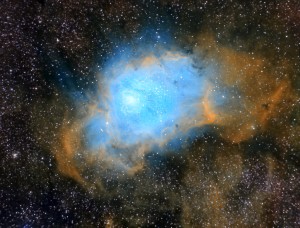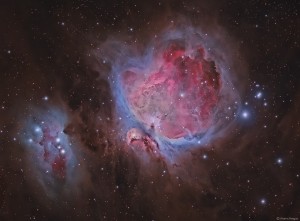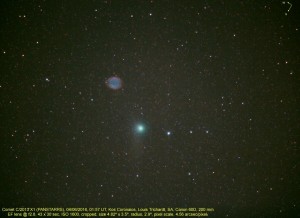August 2019: Messier 8, NGC 6523, Sharpless 25 by John Gill
March 2017: M42 and NGC 1976 by Martin Heigan
The Orion Nebula (Messier 42, M42, or NGC 1976) is a diffuse nebula situated in the Milky Way Galaxy, south of Orion’s Belt in the constellation of Orion. M42 is located 1344 light-years away, and is the closest region of massive star formation to Earth. The M42 nebula is estimated to be 24 light-years across. It has a mass of about 2000 times the mass of the Sun.
Even though the Orion Nebula is probably the first Deep Sky Object that every Astrophotographer images, it is actually a tricky nebula to photograph and process due to its wide high dynamic range of bright and faint nebulosity.
November 2016: NGC 4845 a Spiral Galaxy by Dawie Venter
NGC 4845 a Spiral Galaxy
(also known as NGC 4910) is a spiral galaxy located in the constellation Virgo 47 million light years away
The galaxy has a supermassive black hole at its center with a mass of 300,000M⊙
October 2016: Early Twilight Capture of Mars with Argyre region appearing bright by Clyde Foster
An early twilight capture of Mars with Argyre region appearing bright, although this appears to extend across quite a large area. Clyde said, “Possibly my first capture of the activity that initiated in Hellas and has extended east and west? The fine line of cloud near the SPC is persisting. I have not tried to process out the preceding limb arc.”
August 2016: The Butterfly Cluster by Leslie Rose
The Butterfly Cluster (cataloged as Messier 6 or M6, and as NGC 6405) is an open cluster of stars in the constellation of Scorpius. Its name derives from the vague resemblance of its shape to a butterfly.
Most of the bright stars in this cluster are hot, blue B-type stars but the brightest member is a K-type orange giant star, BM Scorpii, which contrasts sharply with its blue neighbours in photographs. BM Scorpii, is classed as a semiregular variable star, its brightness varying from magnitude +5.5 to magnitude +7.0.
Estimates of the Butterfly Cluster’s distance have varied over the years, with a mean value of around 1,600 light-years, giving it a spatial dimension of some 12 light years. Modern measurements show its total visual brightness to be magnitude 4.2.
July 2016: Comet C/2013 X1 PANSTARRS passing the Helix Nebula on 4 June 2016 by Kos Coronaios
Comet C/2013 X1 was discovered in 2013 by the Panoramic Survey Telescope & Rapid Response System (Pan-Starrs), a widefield imaging facility specifically designed to scan the night sky for asteroids and comets.
The Helix Nebula (NGC 7293) is a planetary nebula in the constellation of Aquarius. Like all planetary nebulae, it is composed of the ejected outer layers of an aging star, fluorescing from the ultraviolet radiation emitted by the intensely hot inner parts of the star.






